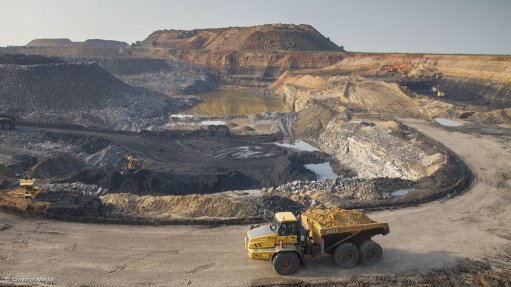
WIDENING PROSPECTS
Several opencast mine exptensions are currently being planned and developed by Menar’s coal mining subsidiaries
Photo by: Creamer Media
Mineral resources investment group Menar’s subsidiary Canyon Coal is ploughing ahead with plans to begin the development of two new coal mines – De Wittekrans, which is near Hendrina, in Mpumalanga, and Bekezela Colliery in Springs, Gauteng – this year.
Menar MD Vuslat Bayoglu said in a statement issued in January that the company would invest about R600-million in the Phase 1 development of De Wittekrans, with the creation of 430 jobs, while Bekezela Colliery will cost about R1.5-billion to develop and will create 800 jobs.
“These mines are being developed with the intent, in part, to provide State-owned power utility Eskom with options to procure the right-quality coal at a competitive price. A major element of supporting Eskom’s turnaround is to reduce costs,” he explained.
Speaking to Mining Weekly, Canyon Coal COO Clifford Hallatt says the company is planning to start developing Bekezela Colliery – otherwise known as Palmietkuilen – once the water-use licence (WUL) is issued by the Department of Water and Sanitation.
“Bekezela Colliery is on the last leg of evaluation in support of the granting of the long awaited WUL. We have had to overcome some major legal hurdles to receive our environmental authorisation,” he says.
The Bekezela Colliery is situated adjacent to the Phase 1 section of Canyon Coal’s Ukufisa Colliery, effectively increasing the life-of-mine (LoM) of Ukufisa, which had an original LoM of about five years.
Clay mining started at Ukufisa in December 2018. The Bekezela Colliery will be an opencast mine, with a target production of 600 000 t/m of run-of-mine (RoM) production once in steady-state production, with a scheduled LoM of 22 years. This period excludes the construction phase of the project.
Meanwhile, the De Wittekrans greenfield project has an estimated LoM of about 25 years, based on a RoM production of 300 000 t/m. Phase 1 – the opencast operation – has an economically minable reserve of 14.3-million tonnes RoM, while Phase 2 comprises the underground operations. Phase 1 consists of three pits, one of which has been designed with the specific purpose of gaining access to the underground reserve.
“We regard the opencast component of this project as the key to unlocking the full potential and it will, therefore, fund the capital for the larger underground section,” Hallatt says.
The mining right, WUL and environmental authorisation have been granted, including the WUL for the opencast operations.
“We also own the farm portion on which all the infrastructure will be developed,” he adds.
Waiting for Approvals
Not all of Canyon Coal’s projects have been able to secure the necessary licences as successfully.
Hakhano Colliery, 20 km east of Middelburg, in Mpumalanga – which was Canyon Coal’s first opencast coal mine – depleted its resources in 2019. Subject to the approval of the required approvals for nearby mining projects, the company plans to restart Hakhano’s processing plants as soon as possible.
However, Hallatt says the processing plant restart has been delayed, as the regulatory approval for the alternative resources is taking longer than expected. The feedstock will come from the nearby Driefontein, Uitkyk and Olifantslaagte resources.
Moreover, Hallatt notes that favourable market conditions and customer demand are key considerations for a successful restart: “The plant is, however, in a good condition, which will allow for a rapid restart and ramp-up”.
Hakhano’s 400 t/h coal processing plant can produce large and small nuts, peas, duff and spiral coal products. The plant also has a 28 t/h filter press system, which was used to reduce Hakhano Colliery’s water consumption by recycling mine water for use in processing.
Meanwhile, the Phalanndwa Colliery, which is near Delmas, in Mpumalanga, was extended in 2019, and plans to execute Phase 2 of that extension are in this year’s project pipeline.
“We are awaiting regulatory approvals for the Phase 2 of the extension, which is at an advanced stage. We look forward to receiving the approvals to retain the jobs of 444 people, including contractors, for the next five years,” Hallatt states.
Canyon Coal employs 931 people, including contractors, across its four operations.
Above Ground and Beyond
Another coal-producing Menar subsidiary, Kangra, is also implementing extension plans at its Savmore/Maquasa coal mine, in Saul Mkhizeville, Mpumalanga, to extend the LoM. This includes opencast and underground extensions.
Kangra’s operations were put on care and maintenance in May last year in response to, among other factors, the damage to local and international markets caused by Covid-19 global lockdowns.
“Low thermal coal prices, owing to a supply glut and low demand, proved unsustainable for the high-cost underground mine,” Kangra said in a statement issued in May last year.
However, a gradual improvement in thermal coal prices, along with internal and external price modelling, has provided confidence that the mine can, once again, operate profitably over the longer term.
The company announced last month that operations have now resumed with the opening of the new opencast investment called Pit C. Kangra is also planning to develop the Kusipongo resource, which is located to the west of the existing mining operations and is a natural extension of Kangra’s current coal resource. It has a coal reserve of about 41.9-million tons and will extend the LoM by more than 20 years.
“The new C-Block opencast pit will produce 25 000 t/m of RoM coal. Additionally, H-block is also operational with two underground sections,” Menar COO Bradley Hammond tells Mining Weekly.
The majority of Kangra’s coal is exported through the Richards Bay Coal Terminal – of which Kangra is a shareholder – in KwaZulu-Natal, for international power producers. The mine’s proximity to Richards Bay positions it well for exports and to service the local markets.